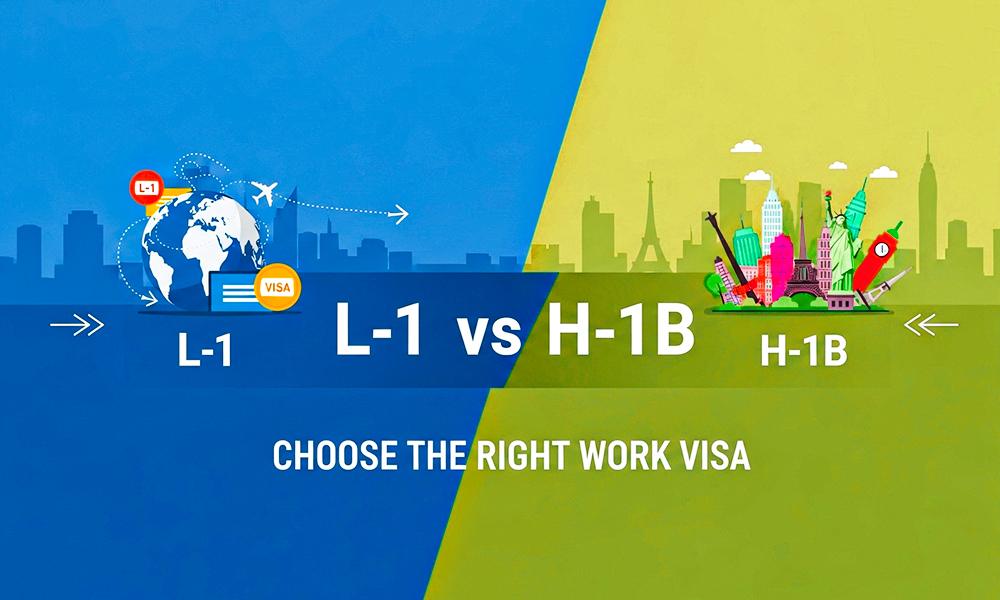When considering work opportunities in the United States, foreign nationals often seek one of the many U.S. work visa options. Among the most commonly applied-for visas are the L-1 and H-1B visas. Both serve distinct purposes and cater to different groups of workers, with unique eligibility requirements, application processes, and benefits. This article will explore the key differences between the L-1 and H-1B visas, providing clarity on which visa may best suit your specific needs.
What is an L-1 Visa?
The L-1 visa is a non-immigrant visa that allows multinational companies to transfer employees from their foreign offices to their U.S. branches, subsidiaries, or affiliates. This visa is essential for international businesses seeking to manage and grow their operations in the U.S.
L-1 Visa Definition and Meaning
The L-1 visa allows foreign employees of a company to work in the U.S. if they are either in an executive, managerial, or specialized knowledge role. The visa comes in two types:
- L-1A: For executives and managers.
- L-1B: For employees with specialized knowledge.
This visa is primarily for employees of international businesses that have offices in both the U.S. and another country.
What is an H-1B Visa?
The H-1B visa is a popular U.S. work visa for foreign nationals employed in specialized occupations that require a bachelor’s degree or higher. This visa is most commonly used in industries like IT, engineering, and healthcare.
H-1B Visa Definition and Meaning
The H-1B visa allows foreign workers to live and work in the U.S. in occupations that require specialized knowledge. Unlike the L-1 visa, the H-1B visa is available to workers who are sponsored by a U.S. employer, and it is not restricted to multinational companies.
Common fields for H-1B visa holders include technology, healthcare, finance, and engineering, where employees are expected to possess at least a bachelor’s degree or its equivalent in the required field.
L-1 Visa Requirements
To qualify for the L-1 visa, the following conditions must be met:
Required Conditions
The applicant must be employed by a multinational company for at least one year within the last three years.
- The applicant must be transferring to a U.S. office of the same employer.
- The employee must hold a managerial, executive, or specialized knowledge position.
Required Documents
- Proof of employment with a multinational company.
- Organizational chart showing the employee’s role in the company.
- Evidence of the relationship between the foreign and U.S. company.
H-1B Visa Requirements
To qualify for the H-1B visa, the following conditions must be met:
Required Conditions
- The applicant must hold a bachelor’s degree or higher (or equivalent experience) in the relevant field.
- The applicant must have a valid job offer from a U.S. employer in a specialized occupation.
- The employer must file a Labor Condition Application (LCA) with the U.S. Department of Labor.
Required Documents
- Job offer from a U.S. employer.
- Educational transcripts and degree certificates.
- Resume/CV.
- Labor Condition Application (LCA) approval.
L-1 Visa vs H-1B Visa: Key Differences
Here’s a comparison of the major differences between the L-1 and H-1B visas:
Feature | L-1 Visa | H-1B Visa |
Visa Purpose | Transfer employees within a multinational company | Employ skilled foreign workers in specialized fields |
Employer Requirement | Must be a multinational company with offices in both the U.S. and abroad | U.S.-based employer must offer a specialty occupation job |
Eligible Employees | Managers, executives, or specialized knowledge employees | Skilled workers with a bachelor’s degree or higher |
Visa Duration | L-1A: 7 years, L-1B: 5 years | Up to 3 years, extendable to 6 years |
Spouse and Dependents | Spouse and children under 21 can accompany on L-2 visa | Spouse and children under 21 can accompany on H-4 visa |
Green Card Pathway | Eligible for permanent residency (Green Card) under EB-1C (for managers/executives) | Eligible for permanent residency via employment-based green cards (e.g., EB-2, EB-3) |
Benefits of the L-1 Visa
- Multinational Opportunities: The L-1 visa allows employees to move between global company offices.
- Pathway to Green Card: L-1A visa holders can directly apply for a Green Card under the EB-1C category.
- Family Benefits: Spouses and children can live in the U.S. on L-2 visas.
Benefits of the H-1B Visa
- Access to U.S. Job Market: The H-1B visa opens up employment opportunities in various high-demand fields.
- Longer Duration: With extensions, the H-1B visa can be valid for up to 6 years.
- Dual Intent: H-1B holders can apply for a Green Card while on the visa without jeopardizing their status.
L-1 Visa Application Process
The L-1 visa process includes several steps:
- Employer files Form I-129: To petition for the transfer of the employee.
- Approval: Once approved, the employee can apply for an L-1 visa at a U.S. consulate or embassy.
- Admission to the U.S.: Upon entry, the employee can work at the U.S. office.
H-1B Visa Application Process
The H-1B visa process includes the following:
- Employer files Form I-129: Along with the Labor Condition Application (LCA).
- Lottery System: H-1B petitions are subject to a lottery if the demand exceeds the cap.
- Visa Interview: Once selected, the employee attends a visa interview at a U.S. consulate.
FAQs
1. Can I apply for an L-1 visa if I haven’t worked for my company abroad?
No, you must have worked for your employer outside the U.S. for at least one year within the last three years.
2. Can I switch employers with an L-1 visa?
No, the L-1 visa is tied to the specific employer who petitioned for you.
3. How long is the H-1B visa valid?
The H-1B visa is initially valid for 3 years and can be extended for up to 6 years.
4. Can I apply for a Green Card with an L-1 visa?
Yes, L-1A visa holders can apply for a Green Card under the EB-1C category for multinational managers and executives.
5. How many H-1B visas are issued each year?
There is a cap of 65,000 H-1B visas per year, with an additional 20,000 available for workers with advanced degrees from U.S. institutions.

